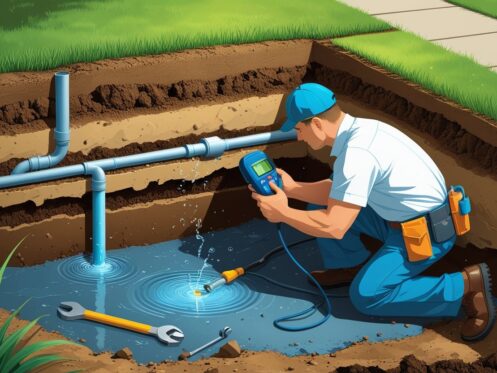Finding a water leak underground can be daunting, especially if you’re unaware of where to start. Plumbers use various methods, including acoustic listening devices and visual inspections, to accurately pinpoint the source of these hidden leaks. Understanding these techniques can not only save you money but also prevent further damage to your property.
With signs like an unexpected rise in your water bill or wet spots in your yard, you may already suspect a leak. When faced with this problem, professional help from a company like Splash Plumbing can make all the difference. Our experienced plumbers are equipped with the latest technology and techniques to identify and repair leaks efficiently.
By learning how experts find underground leaks, you empower yourself to take swift action when plumbing issues arise. The next time you notice suspicious water accumulation, you’ll be better prepared to handle it with confidence and clarity.
Understanding Underground Water Leaks
Underground water leaks can lead to significant damage if not detected and resolved promptly. Recognizing the signs, understanding the potential causes, and being aware of the risks can help homeowners protect their property from severe consequences.
Common Signs of an Underground Water Leak
You may notice several indicators that suggest an underground water leak. These include:
- Unexplained Puddles: Water pooling in your yard, particularly in areas with no previous drainage issues.
- Increased Water Bills: A sudden spike in your water bill could signal a leak in your underground plumbing.
- Wet Spots: Persistent damp areas on your lawn or foundation.
- Cracks in Concrete: Monitor your driveway and home foundation for new cracks, as these can form due to shifting soil caused by leaking water.
- Mold Growth: Excess moisture can lead to mold, which causes health risks if allowed to proliferate.
Identifying these signs early allows for prompt inspections and necessary repairs.
Causes of Underground Leaks
Various factors can contribute to underground water leaks. Common causes include:
- Corrosion: Over time, pipes made of metal can corrode, leading to weak spots that eventually leak.
- Tree Roots: As roots grow, they can infiltrate pipes, causing cracks or breaking the lines entirely.
- Shifting Soil: Seasonal changes in moisture levels can cause your soil to expand or contract, leading to structural stress on pipes.
- Poor Installation: Incorrectly fitted pipes or inadequate materials may lead to leaks as they age.
- Wear and Tear: Over years of use, pipelines naturally degrade, particularly in older homes.
Understanding these causes can help you take preventive measures to maintain a healthy plumbing system.
Risks and Consequences
Ignoring an underground leak can have serious ramifications:
- Structural Damage: Continuous leaking can undermine the stability of your foundation, causing expensive repairs.
- Mold Growth: Moist environments encourage mold, which poses health risks and damages interiors.
- Water Damage: Prolonged leaks can damage flooring, walls, and belongings, leading to costly remediation.
- Sinkholes: In extreme cases, extensive underground leaks may create sinkholes, posing physical dangers.
Prompt detection and repair of underground leaks are essential. If you suspect a leak, consider contacting Splash Plumbing, as they specialize in addressing these plumbing issues effectively.
Initial Steps to Detect an Underground Water Leak
Identifying an underground water leak requires careful observation and methodical steps. You can take initial measures to detect potential issues before calling in a professional. The following techniques focus on checking the water meter, isolating potential sources of the leak, and identifying unusual symptoms around your property.
Checking the Water Meter and Water Bill
Start by examining your water meter. Turn off all faucets and appliances using water, then check the meter reading. If the meter continues to move, this indicates a leak in your system.
Next, review your recent water bill. A sudden increase in your water usage can also signal a leak. For example, if your bill is noticeably higher without an increase in consumption, you may need to investigate further. Regular monitoring of your water bill can help you catch leaks early.
Isolating the Leak Source
Once you’ve confirmed the likelihood of a leak, locate your main water supply valve. Turn it off and monitor if the meter reading changes. If the meter stops moving while the valve is closed, the leak is likely downstream.
If you suspect a specific area, systematically check each fixture connected to the line. Inspect faucets, toilets, and other water-using appliances for signs of leakage. It’s crucial to be thorough in this step, as even small leaks can lead to significant issues over time.
Identifying Unusual Symptoms Around the Home
Look for visible signs of water damage around your home. Puddles, damp spots, or unusual vegetation growth can indicate underground leaks.
Decreased water pressure can also be a strong indicator of a leak. If you notice reduced flow from faucets or showers, it may stem from a leak in the system. Using a leak detector can provide pinpoint accuracy in identifying the leak’s location, minimizing disruption to your property.
For comprehensive plumbing needs, consider reaching out to Splash Plumbing, your trusted plumbing service in the area.
Professional Leak Detection Methods
Professional plumbers utilize advanced techniques to identify underground water leaks effectively. These methods combine specialized equipment with their extensive knowledge to accurately locate and address issues without extensive digging.
Acoustic and Electronic Leak Detection
Acoustic leak detection is a prominent method used to pinpoint underground leaks. This technique relies on sensitive microphones that detect the sound of water escaping from pipes. When used effectively, these leak detectors can identify even the faintest sounds associated with leaks.
Additionally, electronic leak detection uses sensors to monitor pressure changes in the plumbing system. When a drop in pressure is detected, it signifies a possible leak. Plumbers like those at Splash Plumbing are trained in these techniques, ensuring a precise diagnosis without unnecessary excavation.
Using Thermal Imaging Devices
Thermal imaging devices play a crucial role in leak detection. These infrared cameras detect temperature differences in walls and floors, highlighting areas with unseen leaks. Since water temperature often varies from surrounding materials, a professional plumber can quickly identify problem areas.
The use of thermal imaging permits a non-invasive inspection process. By visually representing temperature variations, this method allows for immediate action in addressing leaks, saving both time and potential damage.
Dye and Localization Tests
Dye testing is another effective strategy for locating leaks. This method involves introducing a harmless colored dye into the plumbing system. If a leak is present, the dye will appear outside the pipe, clearly indicating the location.
Localization tests complement dye testing by using food coloring to trace water flow. This straightforward method provides instant feedback on leaks in toilets or other fixtures. As an established plumbing service, Splash Plumbing employs these tests to ensure leaks are promptly identified and effectively repaired.
Evaluating and Repairing Underground Water Leaks
Identifying and fixing underground water leaks requires careful evaluation and effective repair techniques. Addressing these issues promptly can prevent costly repairs and extensive water damage.
Assessing the Extent of Damage
Begin by looking for signs of damage. These may include water pooling in your yard or an unusually high water bill. Inspect surrounding fixtures for any leaks or water stains.
Next, professionals often use tools such as moisture meters to identify areas of excess moisture. This assessment helps pinpoint the damaged section of the pipe. You might also notice dirt displacement or green patches in your lawn, which indicates the presence of water where it shouldn’t be.
Calling a water damage restoration company may be advisable if the damage is extensive.
Repair Techniques for Underground Pipe Leaks
There are several techniques to repair underground leaks, each suited for specific situations. If the leak is small, you may be able to use a pipe sealant to close it. This option is often less invasive.
For more significant leaks, excavation might be necessary. A plumber will dig to expose the broken pipe, remove it, and install a new section. In some cases, trenchless repair methods can be used, allowing the plumber to insert new pipe sections without extensive digging.
Using specialized fittings can also help ensure a leak-proof connection. Always consult professionals like Splash Plumbing for the proper assessment and execution of repairs.
Restoring Affected Areas and Preventing Future Leaks
Once repairs are completed, it’s crucial to restore the affected areas. Fill in the excavated soil and compact it to prevent settling. You may also want to replant grass or other vegetation to restore your landscape.
To prevent future leaks, consider implementing a regular maintenance schedule. This includes inspecting your underground water line and fixtures. Upgrading to higher quality materials can also help reduce the likelihood of future damage.
For ongoing plumbing needs, remember that Splash Plumbing offers comprehensive services to keep your plumbing system in top shape.
Prevention and Maintenance Tips for Homeowners
Taking proactive steps can help you avoid costly leaks and damage in your home. Regular monitoring and maintenance are essential to keep your plumbing in good condition and prevent problems before they escalate.
Routine Plumbing Inspections
Scheduling routine plumbing inspections is vital for maintaining your home’s plumbing system. A licensed plumber from Splash Plumbing can identify potential issues before they become serious. During an inspection, focus on key areas like your water heater, toilets, faucets, and other fixtures.
Check for any visible signs of trouble, such as damp spots on walls or floors, which could indicate leaks. Inspect the areas around appliances, including dishwashers and washing machines, where water may accumulate. Regular inspections ensure that your plumbing remains efficient and minimizes the risk of unexpected failures.
Recognizing Early Warning Signs
Being aware of early warning signs can save you significant time and expenses. Monitor your home for wet spots, pools of water, or persistent dampness, especially in crawl spaces and basements. Unexplained increases in your water bills may also signal a hidden leak.
Look for mildew or mold growth, which thrives in moist conditions and can affect your health. Additionally, observe your property’s yard for sinkholes or erosion, as these may indicate water flowing beneath the surface. Identifying these signs early allows for prompt action to address potential leaks effectively.
Protecting Outdoor Plumbing and Appliances
Protecting your outdoor plumbing is crucial for preventing leaks, especially during extreme temperatures. Insulate exposed pipes, including those in your yard and under driveways, to shield them from freezing. When watering your yard, avoid over-watering, as this can lead to water accumulation and increase leak risks.
Regularly check outdoor appliances, such as hoses and irrigation systems, for wear and tear. Ensure that connections are secure and replace any damaged components immediately. Taking these preventive measures helps maintain a healthy plumbing system, preventing costly repairs down the line.
Frequently Asked Questions
Understanding how plumbers detect water leaks underground can help you manage potential plumbing issues effectively. Here are some common queries that homeowners often have regarding the detection and repair of underground leaks.
What are the common methods used by plumbers to detect underground water leaks?
Plumbers use several methods to find underground leaks. Ground-penetrating radar can help pinpoint the leak’s location without the need for excavation. Acoustic listening devices are also effective for detecting water sounds underground. Infrared cameras may identify temperature changes caused by leaks.
Can homeowners use special tools to locate underground leaks, and if so, what types?
Yes, homeowners can use certain tools to assist in locating leaks. A water meter can help determine if a leak exists by checking if it continues running with all fixtures off. There are also electronic leak detection devices available for purchase that may help locate leaks.
Which professionals should be contacted for identifying and repairing an underground water leak?
You should contact a licensed plumber experienced in leak detection and repair. Companies like Splash Plumbing are equipped with advanced technology to efficiently identify and fix leaks. Ensuring the plumber is licensed and insured will also provide peace of mind.
What are the signs that indicate the presence of a leak between my house and the water meter?
Signs of a leak may include unusually high water bills, wet spots in your yard, or water pooling near the foundation. You might also notice a decrease in water pressure when using faucets or showerheads. Inspecting these symptoms early can help prevent costly damage.
How much can I expect to pay for the repair of an underground water leak?
The cost to repair an underground water leak can vary significantly. Factors include the severity of the leak, necessary excavation, and the complexity of the repair. On average, you might expect to pay anywhere from a few hundred to several thousand dollars, depending on these factors.
What should I consider when choosing a water leak detection service?
When selecting a water leak detection service, consider the company’s reputation, experience, and technology they use. Look for customer reviews and testimonials. Splash Plumbing has a solid history of satisfied clients and offers reliable services to manage your plumbing issues effectively.












